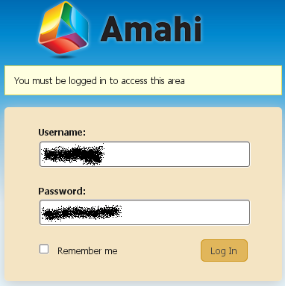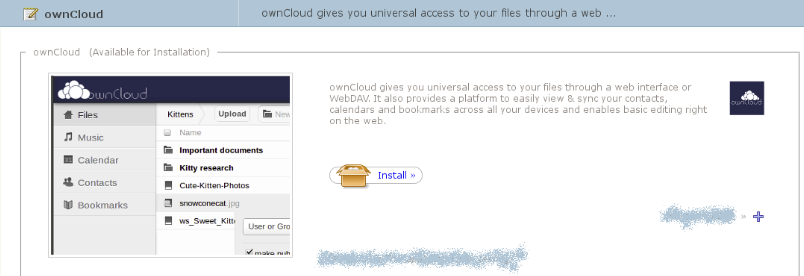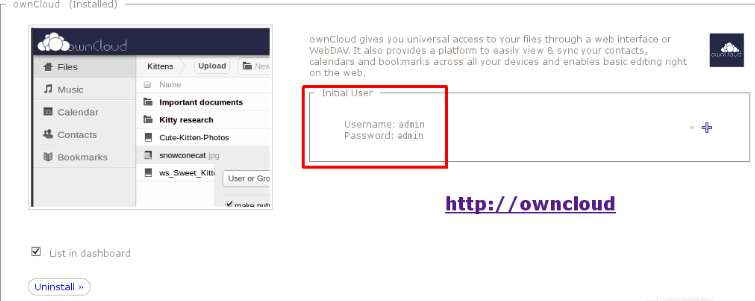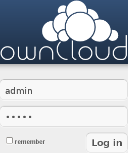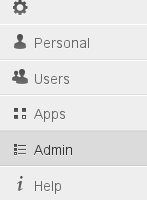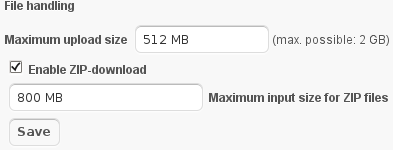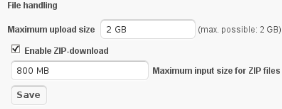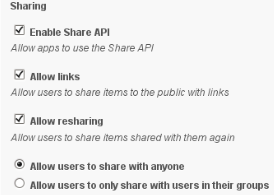OwnCloud on Amahi

|
Work In Progress |
|---|---|
| This article is currently undergoing major expansion or restructuring. You are welcome to assist by editing it as well. If this article has not been edited in several days, please remove this template. |
Each of us has been touched by the term “Cloud Computing” in some way. Either through experience using “public cloud services”, media articles, ravings from I.T. boffins, people naming dropping the latest techie terms ... most sources claiming it's the “greatest thing since sliced bread”.
Many organizations and people have jumped on the public cloud band wagon for various reasons. It's free or cheap. Data is safely stored with the minimum of hassle. It's flexible to access (anywhere, anytime, most any device). There are all sorts of neat applications that can be used to enhance use of the stored data.
All of the above is good stuff, until, reality bites back. In come the litigators, the legal authorities, the public cloud provider “Terms of Use” statements. The “take downs”, cloud service providers going out of business, the organization mergers/buyouts? Information owners who "thought" it was their data discover it's not or access has been cut-off.
Take control of your own data. Bring it home. Use a “private cloud”. Eliminate/minimize the need for a public cloud. If some public cloud access is required then the private cloud can be configured as a “hybrid cloud” (combination of the two).
ownCloud on Amahi is a great combination for home and small business use. ownCloud is a "Cloud Storage" application that provides control of owner data on a private server. Additionally, ownCloud applications can be used to provide enhanced use of owner data (i.e. music streaming, photo gallery).
ownCloud Installation
The Amahi ownCloud installation package is a "one-click install". The following steps show the installation of ownCloud on Amahi.
- To install ownCloud an Amahi user ID with administrator rights is required. Login with this Amahi ID.
- On the HDA Dashboard click on "Apps".
- On the Apps tab click on the Available menu item.
- On the list of Available Apps find ownCloud and click on it.
- The selected ownCloud menu item expands out as a dropdown item.
- Click on "Install" and Amahi begins the installation process. The Amahi installation takes care of; downloading and installing required software dependencies, setting up the ownCloud database, ownCloud "administration" user.
- Once ownCloud has been installed Amahi creates the ownCloud "administration" user ID. Please take note of the user ID login credentials.
- Reboot the server.
- Now to test ownCloud to see if it is running and logging in to the "admin" user ID is important at this point. Here is some access information that will be needed.
Via a web browser to access ownCloud from a... Server Console: http://owncloud Workstation: http://owncloud.server_name
Initial login credentials for the administration user: User name: admin Password: admin
- Using a web browser and the Amahi ownCloud URL the ownCloud Login should appear, login using the admin user ID credentials.
- In the lower left corner of the browser hover over the "gear", "Settings" appears.
- Click on Settings and the owncloud settings admin menu appears. Click on the "Admin" menu item.
- With the mouse grab the slider on the right side and go to the bottom of the Admin display. At the bottom there should be a message indicating the version of ownCloud that is now installed.
- If all of the above happened correctly, ownCloud was successfully installed!
Please Note:
There is no "automatic upgrade" facility for new versions of ownCloud. An administration "update" feature is available, but will only work on a LAMP server using ownCloud install defaults. Once the "one click install" Amahi package has been updated to a new version of ownCloud the package will have to be reinstalled. When reinstalling the ownCloud package make sure all data is backed up.
Configuring ownCloud
Now the ownCloud has been installed some configuration work for the new ownCloud instance needs to be done. In this section only the important configuration aspects of a new ownCloud instance will be covered.
- We start by using the "admin" ID and navigating to Settings => Admin.
- "File Handling" sets limits on the maximum upload and Zip file download sizes.
Maximum upload size: Used for setting a limit on the size for each file to be uploaded to ownCloud. Maximum input size for ZIP files: When checked ownCloud automatically creates a ZIP archive file when multiple files are selected for download. Once the ZIP file is created a download of this file is initiated. When unchecked this feature is disabled only one file at-a-time downloads are allowed.
- In the example below a size of 2 GB is entered followed by clicking the Save button. When the next upload occurs a popup next to the upload button will show the maximum upload per file size allowed by the ownCloud instance.
- ownCloud can store old versions of files when they are updated with a new version. The "Files Versioning" setting effects the entire ownCloud instance, it cannot be used on a per user basis. By default, versioning is enabled. In this example it has been unchecked. Reason? Well first ask the question, how important is it to keep old copies of files in the first place? It might make sense in a small business environment for a shared directory. But for a home environment it might not be important. Each new updated file uploaded in to ownCloud creates a copy of the old file, it all chews up disk space. The ownCloud instance might not have the luxury of additional storage space. Additionally who ever takes care of the ownCloud instance will have to keep watch who is using up all of the system disk space.
When versioning is enabled each ownCloud user has a directory where their old file versions are stored.
/var/hda/files/owncloud/data/<user ID>/files_versions
- The following shows the default settings that are ownCloud instance wide for enabling/disabling "Sharing" of information.
Enable Share API: Allows ownCloud applications to share information. Unchecked sharing for ownCloud applications is disabled. Allow links: Enable/disable use of public links for sharing a file for anonymous users (no recipient ownCloud user IDs required). Allow users to share with anyone: Enabled any instance user setup to share information can reshare that information with other ownCloud instance users. It might be a good idea to initially to disable this until the extent of sharing on the instance is better understood. Allow users to share with anyone: This setting determines if sharing is instance wide for all users or user sharing will be defined by ownCloud Security Groups. It might be a good idea initially to leave it instance wide until the extent of sharing is better understood.
- There initial configuration for the ownCloud instance is done!
Creating Users
<show how to change the admin password> <show creation of normal users and introduce the quota concept>
Things You Need to Know
- ownCloud maintains its own account security system and does not utilize the Amahi host server's user account system.
- There is no "automatic upgrade" facility for new versions of ownCloud. An administration "update" feature is available, but will only work on a LAMP server using ownCloud install defaults. Once the "one click install" Amahi package has been updated to a new version of ownCloud the package will have to be reinstalled. When reinstalling the ownCloud package make sure all data is backed up.
